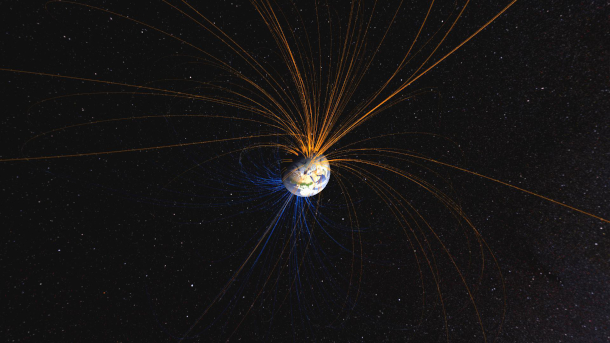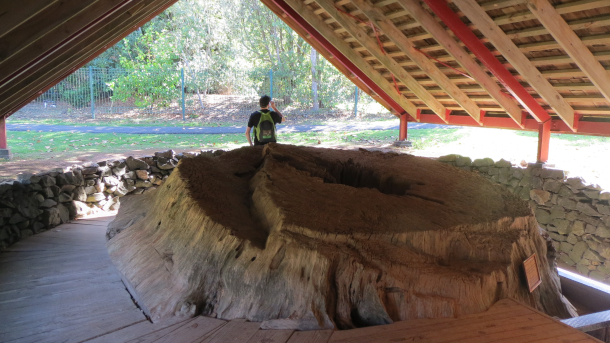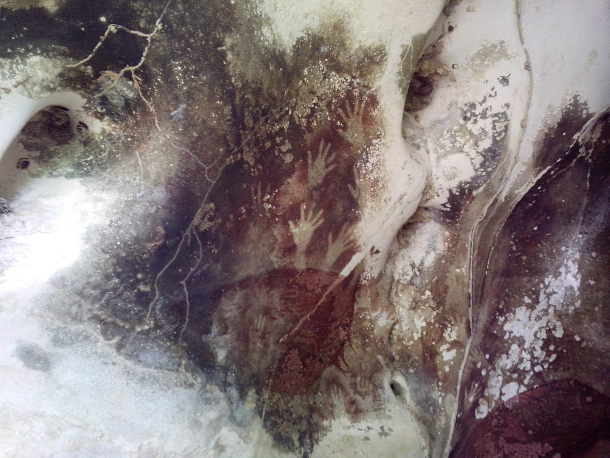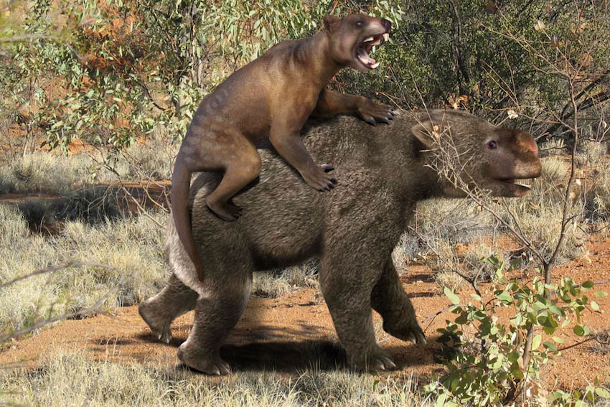Prehistoric Magnetic Flip Shook Up Life on Earth
Air Date: Week of March 26, 2021

Earth’s magnetic field connects the north pole (orange lines) with the south pole (blue lines). (Image: NASA Goddard Space Flight Center)
Earth’s magnetic poles wander around and flip every now and then, and now scientists have evidence for how these flips impact life on Earth. Carolyn Gramling wrote about the research for Science News and joins Host Bobby Bascomb to talk about how a magnetic pole reversal about 41,000 years ago is linked to megafauna extinctions, climatic changes, and even a rise in ancient cave art.
Transcript
CURWOOD: It’s Living on Earth, I’m Steve Curwood.
BASCOMB: And I’m Bobby Bascomb
If you’ve ever used a compass you have probably noticed that it doesn’t exactly point straight to the geographic north pole, but rather to the magnetic north pole north of Hudson Bay in Canada. And recently the magnetic north pole seems to be shifting about 40 miles a year toward Siberia. In the deep past the Earth has even completely reversed its magnetic poles, and the exact reasons for the flip flops aren’t well understood. But thanks to a fossil tree discovery in New Zealand, scientists are getting more insight on how magnetic pole reversals could affect life on earth. The tree dates a magnetic flip about 41,000 years ago when there was a shakeup of life on our planet. For more, I’m joined now by Carolyn Gramling. She is the Earth and Climate writer at Science News. Carolyn, welcome to Living on Earth!
GRAMLING: Thank you. It's great to be here.
BASCOMB: So what exactly causes the magnetic poles to flip every few hundred thousand years, and how do we know it's happening?

A giant stump of the same kind of tree, the kauri, that gave scientists a “Rosetta Stone” to link together a magnetic pole reversal and other events around 42,000 years ago. (Photo: Sheila Thomson, Wikimedia Commons, CC BY 2.0)
GRAMLING: So that is actually an excellent question. And we don't know really what is causing it to happen. What we do know is that Earth has a metallic core, it has a liquid metal outer core, and a solid metal inner core made of iron and nickel. And the interaction between these two cores, and the flow of the minerals within them, actually generates a magnetic field -- generates an electric current, which generates a field. And what we do know is that this magnetic field is, you know, it's like a giant bar magnet at the center of the planet. So it has a north pole and has a south pole. And throughout Earth's history, for millions and millions of years, we know that those poles have occasionally reversed themselves, so that the north pole becomes south, and south becomes north. And we don't really know why that happens. But we know that in the last 20 million years or so that's happened maybe every 200 to 300,000 years. The last time a big reversal happened was about 800,000 years ago. But there are smaller little blips that occur from time to time. And the most recent one of these that we know of was about 41,000 years ago. And they call that the Laschamps Excursion. And it only lasted for a few hundred years, we think. We know this from the rock record, because when rocks are forming, the tiny magnetic minerals that are inside those rocks can orient themselves to align with the current magnetic field, whichever way it's going. And so we see in the rock record, we see these flip flops from time to time. And we saw about 41,000 years ago that there was a period of time when the magnetic field became really weak. And then it reversed itself. And then it reversed itself back. And this whole thing lasted maybe 1500 years, it was a very short, short excursion. But people are very interested in it, because it was recent enough that we're hoping that maybe there's some way that we can figure out: does this kind of event actually affect the creatures living on Earth at the time?
BASCOMB: So this pole reversal was about 41,000 years ago, from what I understand. But scientists are really interested in what happened just before that, is that right?
GRAMLING: Yeah, that's right. So the, yeah, the reversal was 41,000 years ago. But right before the poles actually switched, there's a sort of period of time where they're sort of getting ready to switch. And that lasted even longer than the actual reversal event, maybe about 1000 years. The magnetic field was actually at its weakest during that pre reversal period, it was down to maybe 6% of its current strength. So the big danger period was the period actually around 42,000 years ago, right before the reversal actually happened.
BASCOMB: And so what exactly did happen to life on Earth at that time?

The largest living kauri tree today is called Tāne Mahuta, which is Māori for “God of the Forest”. It’s estimated to be between 1,250 and 2,500 years old. (Photo: W. Bulach, Wikimedia Commons, CC BY-SA 4.0)
GRAMLING: So the trick was, it's such a short period of time that you really need very, very precise dates to be able to, like, link all of these events. So we knew that some large, charismatic animals had gone extinct. Weirdly, it was right around this time that you saw this big uptick in cave art, in humans painting in caves. We knew that there were some climatic shifts that occurred around this time. But being able to link them to this event is the real, the real trick. And so what these guys were able to do was find, basically the Rosetta Stone that they felt could connect all of these events together in time and show they all occurred right around the same time, which was around 42,000 years ago. And that Rosetta Stone was this ancient tree that had been dug up out of a swamp bog in New Zealand.
BASCOMB: Tell me more about that tree, what did the tree show them?
GRAMLING: So the tree, these are trees that, some of them are still living in New Zealand today. They're very ancient coniferous trees, they sort of tower over the forest, they're really distinct. Their antecedents have been around since the Jurassic, so millions and millions of years ago. But these particular trees in this peat bog date back to maybe 50,000 years ago, roughly the right time period. And there's a lot of these giant old trunks, some of them, you know, several meters in diameter, just buried in these bogs and have been preserved there for all this time. And people have been digging them out over time for, for a lot less savory purposes, to use them as like tabletops, or pillars. And that's something that the New Zealand government is cracking down on. But also they're important to science, because they have these very large records of what happened to the climate during this really interesting period of time. And it so happened that in 2019, this one tree was dug up that dates to the exact period of time that we're interested in here. So it was really in the right place at the right time. And researchers were very excited because they knew if we're looking for something that can tell us what happened to the climate 41 to 42,000 years ago, maybe this tree could do it.

Solar radiation streams across space and hits Earth’s magnetic field, which acts like a protective shield around the planet. Note: Sun and Earth not to scale. (Image: NASA Goddard / Bailee DesRocher, public domain)
BASCOMB: And how did the tree do that? I understand that they used carbon dating with it.
GRAMLING: That's right. Yeah, so they can, they basically look at the, the rings of the tree and they can actually see how much carbon-14 was in the tree over time. And carbon-14 is particularly interesting, not just for dating it for age, but also because when you have a weakened magnetic field, you get all these extra cosmic rays coming into the planet. And those cosmic rays interact with molecules in the atmosphere to produce lots and lots of carbon-14. So you see this giant spike in carbon-14 in the tree, and then you can also date that. So they had this really nice record of like, here's what happened to carbon-14 over time. And they can use that to compare with the rock record, and say, okay, we know these things were coincident, isn't that interesting?
BASCOMB: Well, how could a magnetic pole reversal like this have these kinds of dramatic effects on life on Earth?
GRAMLING: What they found was that you end up producing a lot of molecules in the atmosphere that then interact with ozone in the stratosphere. And as we know, when you're eating away the ozone in the stratosphere, you got a problem. So you end up, as a result, increasing the amount of solar radiation that makes it to the surface of the earth. Another thing that happens is that you change how much heat is coming in to the poles relative to the equator. So like, there's more heat at the poles and before, and that changes how the winds move in the high atmosphere, the jet stream, and you end up getting these different atmospheric shifts. There's some evidence at least around the Pacific Ocean, that there was increased glaciation around that time as well.

Red ochre cave art in Pettakere Cave in Indonesia dates to around 42,000 years ago. (Photo: Cahyo Ramadhani, Wikimedia Commons, CC BY-SA 3.0)
BASCOMB: And of course, 42,000 years ago, our own ancestors were living across much of the world. How do we think this magnetic field reversal affect them?
GRAMLING: Yeah, that's a really interesting angle for this. There is a documented rise in cave art right around 41, 42,000 years ago. And they know that because in the caves, you get the cave paintings. And then over those, over time, you might get stalactites and stalagmites growing and you can date those growths. And so they know that this rise in these paintings occurred around that time. And they also saw these paintings that had these red outlined handprints, made out of red ochre. And it turns out that in some indigenous communities, they still use red ochre today as a sunscreen. So, is it possible that you have this extra UV radiation coming in, and all of a sudden you have humans in caves more, making this cave art with the red ochre paint, is it possible that that could have been because they were taking shelter from the increased radiation from the sun during that time?
BASCOMB: And using more sunscreen.
GRAMLING: And using more sunscreen, yes!

Thylacoleo, the marsupial “pouch lion”, depicted attacking the giant wombat Diprotodon. Both megafauna went extinct around 42,000 years ago. (Image: roman uchytel, Wikimedia Commons, public domain)
BASCOMB: And it was around 40,000 years ago that Neanderthals actually went extinct. To what extent do you think there's a relationship there?
GRAMLING: That's also one possibility, that with the rapidly changing climate, it may be that humans were able to outcompete Neanderthals for whatever resources were becoming more scant. And of course, there were these megafauna extinctions, particularly in Australia, they note, for example, there was a giant kangaroo that went extinct around that time, and some other strange Australian animals. There was a type of carnivorous marsupial, sometimes called a pouch lion, that went extinct. A bucktoothed wombat, that stood at about six feet tall. So all of these things were happening right around that same time.
BASCOMB: And so fans of the book Hitchhiker's Guide to the Galaxy will be interested to learn that there's also a connection there. Can you tell us about that?
GRAMLING: Yeah, this is one of the things that I thought was super fun about this was, because what they were zooming in on was this period of time, right around 42,000 years ago, they called it the Adams Transitional Event, named after the author Douglas Adams, who wrote The Hitchhiker's Guide to the Galaxy series, among other books, and also claimed that 42 is "the answer to life, the universe and everything".

Carolyn Gramling is the Earth & Climate writer at Science News. (Photo: Courtesy of Science News)
BASCOMB: Maybe he was onto something there!
GRAMLING: [LAUGHS] Maybe! So yeah, that's a nice tribute to Douglas Adams.
BASCOMB: Well, Carolyn, what do we know about when the Earth might have another pole reversal?
GRAMLING: So in the last 170 years or so, people have tracked that the strength of our magnetic field has decreased by about 9%. So there are some people who are wondering, are we in the middle of a pre, pre-reversal period right now? Is that, is that what's happening? There are also, in the last decade or so the magnetic north pole was wandering a bit oddly, and so there was some concern like, is it about to flip again? The last big magnetic reversal that happened on Earth was the one about 780,000 years ago, and it was happening every two to three hundred thousand years. It does feel like we're maybe overdue.
BASCOMB: Carolyn Gramling is the Earth and Climate Writer at Science News. Carolyn, thank you so much for sharing this fascinating story with us.
GRAMLING: Thank you, it was great! Thank you.
Links
Living on Earth wants to hear from you!
Living on Earth
62 Calef Highway, Suite 212
Lee, NH 03861
Telephone: 617-287-4121
E-mail: comments@loe.org
Newsletter [Click here]
Donate to Living on Earth!
Living on Earth is an independent media program and relies entirely on contributions from listeners and institutions supporting public service. Please donate now to preserve an independent environmental voice.
NewsletterLiving on Earth offers a weekly delivery of the show's rundown to your mailbox. Sign up for our newsletter today!
 Sailors For The Sea: Be the change you want to sea.
Sailors For The Sea: Be the change you want to sea.
 The Grantham Foundation for the Protection of the Environment: Committed to protecting and improving the health of the global environment.
The Grantham Foundation for the Protection of the Environment: Committed to protecting and improving the health of the global environment.
 Contribute to Living on Earth and receive, as our gift to you, an archival print of one of Mark Seth Lender's extraordinary wildlife photographs. Follow the link to see Mark's current collection of photographs.
Contribute to Living on Earth and receive, as our gift to you, an archival print of one of Mark Seth Lender's extraordinary wildlife photographs. Follow the link to see Mark's current collection of photographs.
 Buy a signed copy of Mark Seth Lender's book Smeagull the Seagull & support Living on Earth
Buy a signed copy of Mark Seth Lender's book Smeagull the Seagull & support Living on Earth

